
Pediatrics(2)
.pdf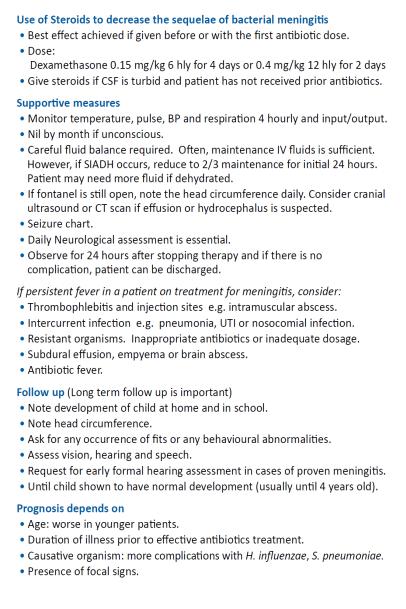
-
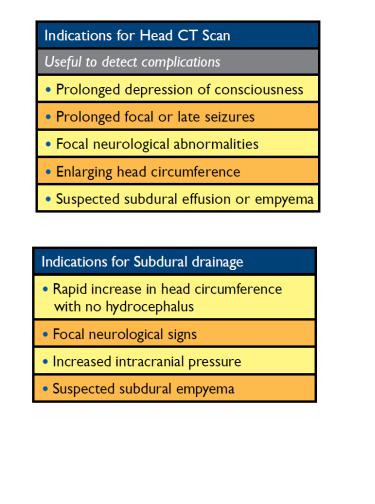
-
-
-
-
-
-9.3. Tetanus
-Definition: Tetanus is toxi infection of the nervous system with the
-potentially deadly bacteria clostridium tetani (C. tetani). It occurs in
-several clinical forms including generalized, neonatal and localized
-disease.
-Cause
-- Clostridia tetani
-Signs and Symptoms
-- Trismus (lock jaw)
-- Opisthotonos (Rigid arching of back mucles)
-- dysphagia
-- Laryngospasm
-- Autonomic nervous system instability with hypertension,
-tachycardia and dysarhythmias
-Complications
-- Asphyxia
-- Heart failure
-- Pneumonia
-- Fractures
-- Brain damage due to lack of oxygen during spasms
-Investigations
-- No specific lab test is available to determine the diagnosis of
-tetanus
-- Other tests done to rule out meningitis, rabies, strychnine
-poisoning etc.
-Management
-Non-Drug Treatment
-• Admit to High or Intensive Care Unit (if available)
-• Oxygen to prevent hypoxia and ventilatory support if needed
- • Monitor:
-→ Temperature
-→ Respiration
-→ Heart rate
-→ Blood gases
-→ Sao2
-→ Blood Pressure
-→ Blood glucose
-→ Electrolytes
-→ Acid–base status
-• Protect the patient from all unnecessary sensory and other stimuli
-• Ensure adequate hydration and nutrition
-• Wound care and debridement/umbilical cord care
-• Educate parents/caregivers regarding prevention of tetanus by vaccination
-Pharmacological
-• Tetanus immunoglobulin, IM, 500–2 000 IU as a single dose
-• Eliminate toxin production
-→ Benzylpenicillin (Penicillin G), IV, 50000IU/kg/day (Neonate every 12hours and in older children every 6 hours)
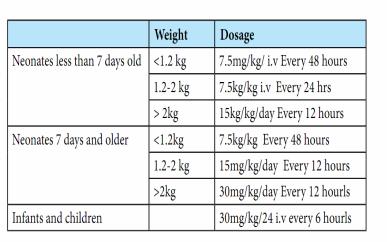
-→ Metronidazole 40mg/kg/day IV in three divided doses for 7-10 days
-
-→ Diazepam, IV, 0.1–0.2 mg/kg/dose 4–6 hourly,
-titrated according to response. do not exceed dose
-of 10 mg/dose. Alternating with chlorpromazine 0.5 mg/kg every 6 hours PO (NGT)
-After recovery from tetanus, patients should be actively immunized as the disease does not confer immunity
-Note: Don’t remove the nGT from the child until at least one week
-seizure free
-Prevention of tetanus
-- Minor Wounds
-• Children with clean minor wounds do not require tetanus immunoglobulin or antibiotics
-• Tetanus vaccine should be given, except in fully immunised patients who have received a booster within the past 5 years
-- For more severe wounds
-• If child with penetrating wound not completely immunised
-→ Tetanus immunoglobulin, IM
-< 5 years 75 IU
-5–10 years 125 IU
-> 10 years 250 IU
-→ Tetanus Toxoid vaccine (TT), IM, 0.5 ml
-→ Phenoxymethyl penicillin, oral, 12.5 mg/kg/dose every 6 hours
for 7 days Or
-→ Erythromycin, oral, 6.25–12.5 mg/kg/dose, every 6 hours for 7 days (f allergic to penicillins)
-Recommendation
-- Refer all severe cases of tetanus to Intensive Care Unit
-9.4. Hepatitis
-Definition: It is an acute inflammation of the liver with varying degrees of hepatocellular necrosis. The most commonly known are hepatitis A, B and less commonly C, d and E viruses.
-HEPATITIS A
-Causes
-- Hepatis A RNA (virus)
-- Vaccination does exist but provided in developed countries
-- HAV is spread via the fecal-oral route
-Signs and Symptoms
-- Abrupt onset with nonspecific symptoms, such as fever, malaise,
-anorexia, vomiting, nausea, abdominal pain or discomfort, and diarrhea
-- Jaundice usually occurs one week after onset of symptoms, along with coliuria (bilirubin in the urine) and mild hepatomegaly
-- Several young children are asymptomatic. Symptomatic 30% of infected children who are younger than six years of age, jaundice usually lasts for less than two weeks. Conjugated bilirubin and aminotransferases returns to normal within two to three months
-- In contrast, older children and adults with HAV infection are usually symptomatic for several weeks. Approximately 70% are jaundiced, and 80% have hepatomegaly. Symptoms lasting for a longer time
-- The most common extrahepatic manifestations include an evanescent rash (11%) and arthralgias (14%). And less common
-extrahepatic manifestations include vasculitis, arthritis, optic neuritis, transverse myelitis, encephalitis, and bone marrow suppression
-Complications
-- Acute liver failure is rare in developed countries , but account for 60% of liver failure in Latin America
-- death
-Investigations
-- Liver Function tests
-- Anti-HAV IgM in a patient with the typical clinical presentation
-- Serological tests for Hepatitis A
-Management
-- Improved sanitary conditions, adherence to sanitary practices,
-hand washing +++ (virus may survive for up to four hours on the fingertips)
-- (Chlorination and certain disinfecting solutions are sufficient to inactivate the virus)
-- No specific treatment for Hepatitis A
-- Bed rest may be recommended
-- Active vaccine is recommended for all children 1224 months
-- Human immunoglobulin prophylaxis for those who had contact
-Patients rarely require hospitalization except for those who develop
-fulminant hepatic failure. The following criteria were proposed by the Pediatric Acute Liver Failure Study Group:
-• Absence of known chronic liver disease
-• Evidence of hepatic injury
-• PT>15 and/or INR>1.5 with encephalopathy
-• PT>20 and/or INR>2.0 with or without encephalopathy
-These criteria should be fulfilled within eight weeks from the onset of illness, and the above-described coagulopathy (prolonged prothrombin time and/or INR) should be unresponsive to vitamin
-K therapy. If suspicion refer to a specialist.
-HEPATITIS B
-Causes
-- Hepatitis B dNA virus (HBV)
-- Perinatal transmission remains the most important cause of chronic infection because of high rates of disease in pregnant women
-- Infants born to women with HBV infection (HBeAg positive or negative) shall be tested for hepatitis B at 9 – 18 months even if vaccinated (at least 5% develop chronic HBV)
-- Hepatitis B vaccination is part of national immunization program
-- All pregnant women should be screened for HBV infection
-Signs and Symptoms
-Infection with HBV is associated with characteristic changes in the serum levels of hepatitis B antigens and antibodies. These markers are used to define different clinical states
-Acute hepatitis
- • Acute HBV infection in children has a variable course ranging from asymptomatic infection to fulminant
-hepatitis.
-→ Constitutional symptoms, anorexia, nausea, jaundice and right- upper-quadrant discomfort
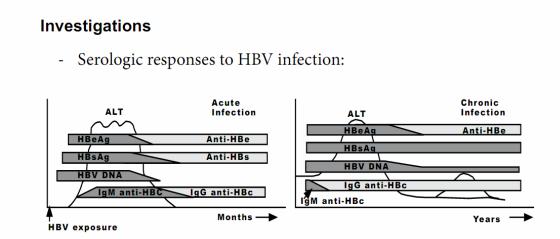
-→ The symptoms and jaundice generally disappear after one to three months, but some patients have
-prolonged fatigue even after normalization of serum aminotransferase concentrations. Older children and adolescents have mild constitutional symptoms
-during acute HBV infection
-Chronic hepatitis
-•Most children with chronic HBV infection are asymptomatic and grow and develop normally. Some
-children note vague right upper quadrant discomfort and fatigue, loss of appetite, occasional boots of mild jaundice.
-Chronic HBV infection is occasionally associated with extrahepatic manifestations including polyarteritis nodosa and glomerulonephropaty. The diagnosis of chronic HBV
-infection is based on persistence of HBsAg for more than six months; IgG anti-HBc is positive, while IgM anti-HBc is negative.
-Note: Some carriers have large numbers of HVB in their serum and liver without symptoms or signs and without antibodies in their serum.
-
-- Left panel: Acute infection: HBeAg (hepatitis B e antigen),
-HBsAg (hepatitis B surface antigen), and HBV dNA beginning in the preclinical phase. IgM anti-HBc (hepatitis B core antigen) appears early in the clinical phase; the combination of this
-antibody and HBs Ag makes the diagnosis of acute infection.
-- Recovery: normalization of the serum ALT, the disappearance of HBV dNA, HBeAg to anti-HBe seroconversion, and subsequently HBsAg to anti-HBs seroconversion and switch from IgM to IgG
anti-HBc. Then previous HBV infection is characterized by antiHBs and IgG anti-HBc.
-- Right panel: Chronic infection Persistence of HBsAg for more than six months after acute infection is considered indicative of
-chronic infection: persistence of HBeAg (for a variable period), HBsAg, and HBV dNA in the circulation; anti-HBs is not seen
-Other tests
-• Liver Function tests (Prothrombin time, Bleeding time)
-• Glycemia if severe
-• HBV tests (refer to figure)
-• Blood ammonia
-• Urea and electrolytes in cases of liver failure
- • CBC to determine severity of anaemia
-Complications
-- Chronic Liver disease: In children born from infected mothers approximately 76% of children remained HBeAg positive at 10 years of age. Rates of spontaneous seroconversion are less than
-2% per year in children younger than three years of age, and 4 to 5% after age three. The frequency of spontaneous seroconversion increases during puberty (Cirrhosis)
-- Liver failure (hepatic encephalopathy) Portal hypertension (GIT bleeding, hematemesis and melena
-stools) Glomerulonephritis /Renal failure
-- Liver cancer
-Management
-- General measures
-• Counseling of the patient including alcohol use in adolescents and family, surveillance for disease progression
-and development of complications
-• Patients who are in the immune tolerant phase of HBV infection (ie, HBsAg positive, HBeAg positive, serum HBV
-dNA>20,000 copies/mL) should undergo monitoring of liver biochemical tests every 6 to 12 months
-• Patients who are in the inactive carrier phase of hepatitis B infection (ie, HBsAg positive, HBeAg negative, anti HBe positive, persistently normal ALT/AST levels, serum HBV
-dNA <10(5) copies/mL) should undergo monitoring of liver biochemical tests every 6 to 12 months
-- Selection of patients for treatment:
-• Treatment is generally considered in patients with HBV
-dNA positive chronic hepatitis who are in the immune active phase (usually defined as ALT/AST >2 times Upper Limits of Normal and HBV dNA >20,000 IU/mL or 10(5) copies/mL, for at least six months)
-• Children with ALT values greater than 10 times the upper limit of normal but with concomitant low HBV dNA levels may be in the process of spontaneous seroconversion, and may not require treatment. These patients should be observed for several months with serial serologic testing
-• If there is evidence of hepatic decompensating, such as jaundice or coagulopathy, treatment should be initiated earlier
-• Several other considerations may be relevant to treatment decisions (co-infected with HCV, HIV or HdV)
-- Choice of treatment
-• Lamivudine and interferon (IFn), are licensed for use in children
-• Adefovir approved for use in children over 12 years of age
-• Licensed in children with HIV and is a first choice for HBV in adult
-• Start using Lamivudine and TDF
-Diseases
-• Use IFN alfa as the first-line treatment (but expensive) for patients with serum ALT more than twice the upper limit of normal, have positive HBeAg, who are committed to adhering to the treatment, and have no comorbid diseases that might be exacerbated by an immunostimulatory agent
-• If the patient does not respond to IFN alfa (defined by detectable HBV dNA and elevated serum ALT six months after completion of the course of IFN alfa), a nucleoside/nucleotide analog such as Lamivudine or adefovir can be used – this shall be considered as primary treatment if IFN alpha is not available
-9.5. Acute Liver Failure
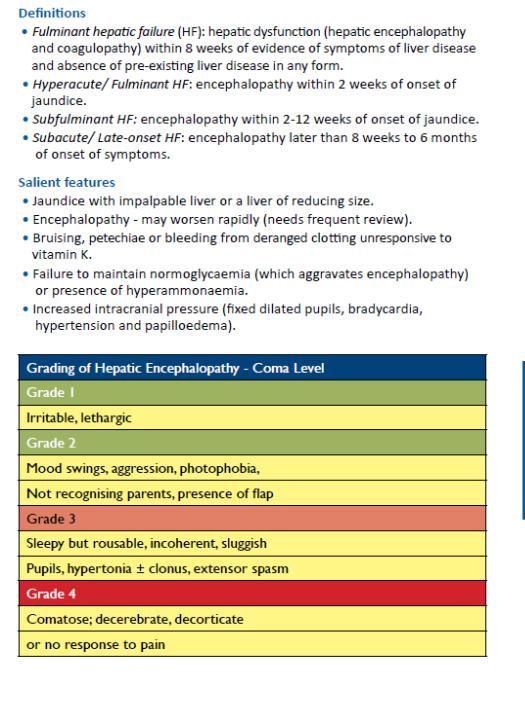
-
